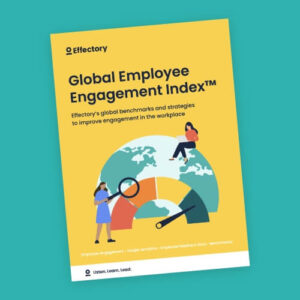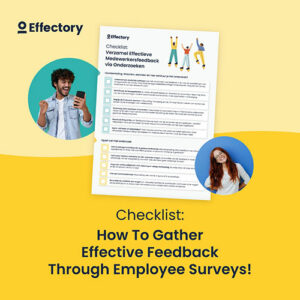There are so many employee engagement strategies, models, and ideas on improving employee satisfaction it’s easy to get lost in the whirlwind of information. Let’s take a step back and look at what is employee engagement definition, from the perspective of the employee, organization, and customer.
Employee engagement definition

What is employee’s engagement definition?
First off, what is engagement? Engagement is defined as:
en-gaged (adj.)
Being involved in an activity. Being greatly interested: committed
Those terms are broad. They might not mean much to an HR manager who’s looking to impassion their workforce through engagement. In fact, that’s exactly how we define engagement. Engaged employees consider their work, their passion. They put their energy and creativity into what they do. They have pride in their work, and at the same time find energy and joy from both the process and end result.
The benefits od employee engagement
Global Employee Engagement Index™
Discover the Global Employee Engagement Index™ 2025 for key insights on driving employee engagement, improving performance, and enhancing team dynamics.
DownloadEmployee engagement is passion
Just like other passions – travel, food, family & friends, relationships – engagement in employement has three defining characteristics.
- Time flies – time will slip by for people deeply engaged in their work
- Work gives energy – it keeps you going, and doesn’t drain you
- Ample motivation – employees want to do their work everyday
Now that we’ve seen what is employee engagement definition, let’s look at why this matters for an organization. We can talk about added value, ROI, key performance indicators – all important factors for delving into employee engagement research. However, at the core of the matter is the importance of the human factor, and that can be split into three categories: the employee, the organization, and the customer.
The employee
We’ve already defined how engaged employees bring passion to their job – and similarly, also to their work space and colleagues, being more productive and making better use of company resources. Not only this, engaged employees act as boots-on-the-ground advocates for their work and are happier in their daily lives (source).
The organization
For the organization, simply put, and engaged workforce increases employee retention and loyalty. If employees are engaged, they’re less likely to leave or be tempted to look for jobs outside the organization. Also, high employee engagement is linked to increased profitability and business performance.
The customer
Customers will experience better service by engaged employees, resulting in better customer retention and increased spending. Build strong, lasting relationships with your customers through partnerships, and do so with a workforce that will go beyond their normal call of duties to support the customer.
How to gather feedback from your employees
The definitive checklist for creating your employee engagement survey.
DownloadHow do you drive employee engagement?
Building the framework for an employee engagement strategy isn’t an overnight task. It might take some time, but here’s a couple tips on how to get started and drive your employee engagement.
C-level and management
There’s a direct link between employee engagement and c-level management. When researched, we found that when employees have confidence in the c-level direction, they are nine times more likely to be engaged in work and committed to the organization. Without management buy-in on engagement, driving workforce engagement is ineffective and often futile.
Start with baseline measurement
To be able to improve engagement, measurements must be performed to create a benchmark, or a jumping off point to the process of further engaging a workforce. This can be done with companywide surveys, feedback sessions, or monitoring behavior to get a clear idea of the level of engagement within the organization.
Education and implementation
Once a benchmark has been set, a variety of actions can be taken to help improve employee engagement. Creating opportunities for education through workshops, and establishing an open environment for feedback collection, and maintaining clear communication across all levels of the organization are viable steps for improvement in workforce engagement.
Don’t drop the ball!
Follow up on all the efforts put into driving workforce engagement, by continuously monitoring engagement levels, and refining the processes.
The difference between engagement & committment
A common misconception means employee engagement doesn’t mean that an employee has a bond with the company they work for. An employee can be engaged with their work, but can easily leave to do the same work elsewhere. The bond between the company and employee falls under employee commitment.
Book a free demo. See our solutions in action.
Effectory is Europe’s Leading provider of Employee Listening Solutions. Schedule a product demo and discover how to enhance your employees’ engagement.
Demo request

